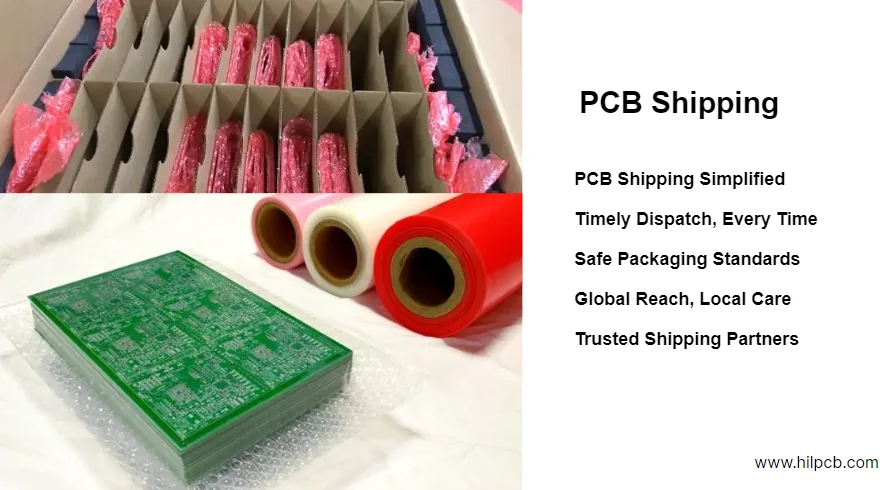Shipping printed circuit boards (PCBs) requires more than just sending a package—it’s about balancing speed, cost, and protection at every stage. Whether you’re shipping small prototype batches or large production orders, proper planning ensures your boards arrive on time and in perfect condition.
This guide explains everything you need to know about PCB shipping best practices—from choosing the right carrier and packaging method to reducing international freight costs. For full delivery management strategies, see PCB delivery.
1. Choosing the Right Shipping Carrier
The right shipping partner can make or break your PCB logistics. Carriers differ in speed, pricing, and reliability, so choosing wisely prevents costly delays and damaged products.
Express Couriers (FedEx, DHL, UPS)
Best for lightweight shipments under 20kg or urgent prototypes. They offer fast, trackable door-to-door delivery worldwide. Expect to pay a 40–60% premium over standard rates, but reliability is unmatched.
Regional Carriers
For domestic routes, regional couriers like OnTrac (US) or DPD (Europe) provide cost-efficient options—typically 20–30% cheaper than international express carriers. However, tracking and cross-border support may be limited.
Freight Forwarders
For larger or international shipments, freight forwarders coordinate multiple carriers, handle customs documentation, and often secure better rates through volume deals. They’re ideal for loads exceeding 20kg, offering flexibility and 30–50% cost savings.
Air Freight & Ocean Freight
Air freight is faster but costlier; ocean freight is economical for volumes above 100kg, though it takes 3–6 weeks. This method is best for large, non-urgent shipments with well-planned PCB inventory management.

2. Packaging Standards That Prevent PCB Damage
Proper PCB packaging protects your investment by preventing static discharge, moisture exposure, and mechanical impact. A single damaged shipment can cause rework, schedule delays, and unnecessary costs.
1. Anti-Static and ESD Protection
Bare PCBs must be sealed in anti-static bags to prevent static discharge.
- Pink or black bags for bare boards
- Metallized shielded bags for assembled boards with ICs or sensors
2. Moisture Barrier and Vacuum Sealing
Vacuum-sealed moisture barrier bags with desiccant packets protect boards from humidity and oxidation—essential for finishes like OSP and immersion silver.
3. Physical Shock Absorption
Use bubble wrap, foam, or air pillows for cushioning.
Rigid separators between stacked boards prevent flexing and edge damage.
For delicate assemblies, custom foam inserts hold boards firmly in place during transit.
4. Sturdy Exterior Packaging
Double-wall corrugated boxes rated for weight ensure safe handling. Heavy shipments may require reinforced crates. Always mark boxes with “Fragile,” “This Side Up,” and orientation arrows to guide handlers.
Packaging built to these PCB logistics standards safeguards boards from production floor to destination.
3. Reducing International Shipping Costs
International PCB shipping costs depend on weight, distance, carrier type, and customs duties. Knowing how to plan shipments can save up to 50% on logistics expenses.
Optimize Package Dimensions
Carriers charge by dimensional weight (L×W×H ÷ 5000 for express). Minimize box size without compromising protection to reduce billed weight.
Choose the Right Service Level
Next-day or two-day express services cost 50–100% more.
Standard 5–7 day express or 7–10 day air freight through forwarders can save 30–50% while maintaining reliability.
Understand Total Landed Costs
Import duties on PCBs typically range from 5–15% of declared value, plus VAT or GST (10–25%).
Brokerage fees and taxes must be included in total PCB cost estimates for accurate budgeting.
Consolidate Shipments
Combine multiple orders into fewer large shipments to share fixed costs like brokerage and documentation. This method works best when your PCB lead time allows flexible scheduling.

4. Documentation and Compliance Essentials
Accurate paperwork is critical for international shipping efficiency.
Incomplete or incorrect documentation is the most common reason for customs delays.
- Commercial Invoice: Include sender/recipient details, HS code (8534.00 for printed circuits), declared value, and currency.
- Packing List: List all items, quantities, dimensions, and weights for customs verification.
- Certificate of Origin: Optional but valuable for reduced duties under free trade agreements.
- Export License: Required only for PCBs with encryption, RF, or defense applications.
Partnering with experienced forwarders ensures your documentation aligns with destination regulations and your PCB sourcing process.
5. Frequently Asked Questions About PCB Shipping
What’s the best way to ship PCBs internationally?
For small, urgent orders, use express couriers like DHL or UPS. For larger shipments, freight forwarders offer more cost-effective air or sea options with customs support.
How do I protect PCBs from damage during shipping?
Use anti-static bags, vacuum sealing with desiccants, foam cushioning, and double-wall boxes. Label clearly and prevent movement inside the package.
How can I lower PCB shipping costs?
Combine multiple orders, use standard air freight instead of express, and optimize packaging dimensions. Consolidating shipments around your PCB supply chain planning saves the most.
Do I need insurance for PCB shipments?
Yes, especially for high-value boards or large production runs. Standard carrier liability is minimal—purchase insurance covering full replacement value (usually 1–3% of declared value).
What documents are required for customs clearance?
At minimum: commercial invoice, packing list, and HS code. Some countries require certificates of origin or import licenses, depending on product classification.
How long does PCB shipping take?
Domestic shipments take 2–5 business days. International air freight takes 3–7 days, while ocean freight for large volumes can take up to 3 weeks.
6. Conclusion
Safe, efficient PCB shipping combines intelligent carrier selection, proper packaging, and proactive cost management. By optimizing documentation, choosing the right logistics partners, and consolidating shipments, you can minimize risks and expenses—while ensuring every board arrives on time and in top condition.
At HILPCB, we go beyond manufacturing by offering integrated logistics support—from secure packaging and export documentation to global freight coordination. Our end-to-end supply chain solutions ensure your PCBs are delivered safely, quickly, and cost-effectively, no matter where your production line is located.

